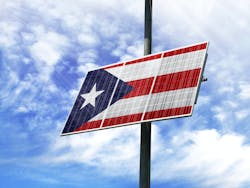DOE Releases $13.85 Million to Advance Solar and Battery Installations in Puerto Rico
To further its efforts to improve the energy resilience of vulnerable households in Puerto Rico, the U.S. Department of Energy (DOE) announced this week that it has awarded two nonprofits and 16 community organizations a total of $13.85 million to facilitate the deployment of residential solar and battery systems.
The funds will come from the 2023 Puerto Rico Energy Resilience Fund (PR-ERF), a $1 billion fund that aims to lower energy costs, improve energy resilience for vulnerable communities and help Puerto Rico achieve its goal of 100% renewable energy by 2050.
It plans to accomplish these goals by installing solar and battery systems on up to 40,000 single family homes across Puerto Rico.
This is the second round of funds distributed by the PR-ERF, which released $450 million in July.
Vulnerable communities are the priority
“For Puerto Rico’s most vulnerable residents, a power outage can be a matter of life or death,” said Jennifer Granholm, U.S. Secretary of Energy. “The success of the Puerto Rico Energy Resilience Fund depends on community trust and engagement, and our DOE team is excited to work with a committed network of local organizations that know the critical needs of their neighbors best.”
The two nonprofits selected in this round, Hispanic Federation and the Institute for Building Technology and Safety, will share up to $10 million to provide ongoing consumer education and training on the solar and battery system, as well as lead consumer protection initiatives.
Sixteen community groups will share the PR-ERF’s $3.85 million Solar Ambassador Prize. These groups will use the funds to identify households eligible to participate in the residential solar and battery program.
Per the PR-ERF’s mandate, priority will be given to very low income, single-family households that are either located in very low income areas prone to frequent or extended power outages, or that have a resident with a medical condition that requires reliable power, such as being in an electric wheelchair or using a home dialysis machine.
It is expected that the first solar and battery installations will begin in spring 2024.
Rebuilding Puerto Rico’s electric grid from the ground up
A string of hurricanes have devastated the U.S. commonwealth of Puerto Rico in recent years. In the wake of 2017’s Hurricane Maria, many communities were without power for six months or more.
Rather than just rebuild the traditional electric grid, the federal and commonwealth governments, as well as many individual communities, are blazing new trails when it comes to power delivery systems and the integration of renewables.
Solar microgrids are one of the tools being deployed across the country, especially in remote villages like Adjuntas in western Puerto Rico. The village has two decentralized community-owned microgrids in its town square and will soon play host to a new microgrid orchestrator from Oak Ridge National Laboratory. The orchestrator will establish a network of microgrids that can be managed as a single cluster – creating a grid of microgrids.
Track news about microgrids. Subscribe to the free Microgrid Knowledge Newsletter.








